Real-time data processing has become essential for modern businesses that need to make quick decisions based on fresh information. Traditional batch processing methods often create delays that can hurt business outcomes. Combining Kafka’s powerful streaming capabilities with dbt’s proven data modeling approach allows teams to build reliable, real-time data pipelines using familiar SQL skills and workflows.
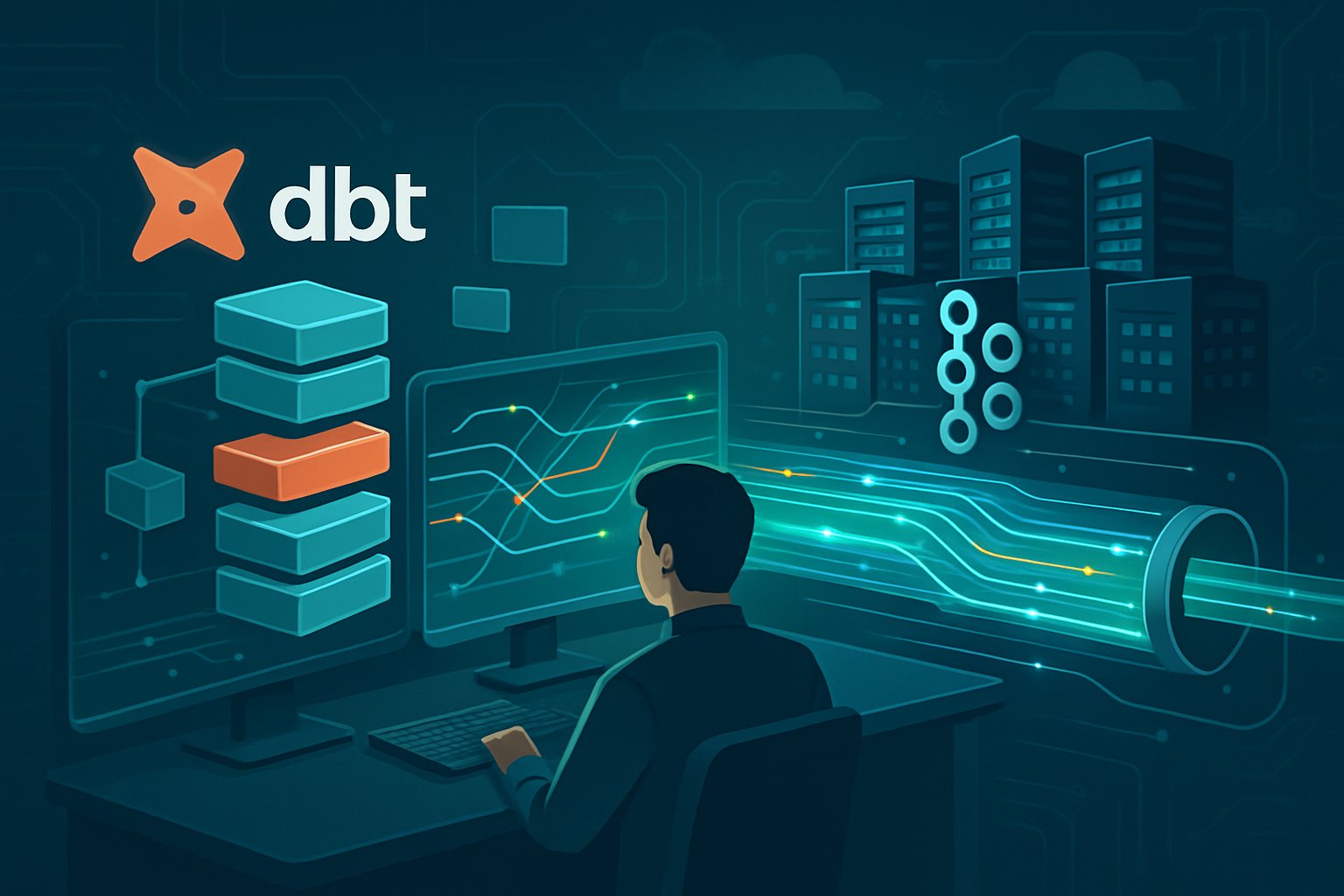
Many organizations struggle with streaming analytics because it typically requires different tools and knowledge than batch processing. Kafka excels at handling high-volume data streams from multiple sources, while dbt provides the structure and testing needed for quality data models. When these technologies work together, data teams can transform streaming events into clean, organized tables without learning entirely new systems.
This comprehensive guide walks through the complete process of building streaming data models that deliver real-time insights. From setting up the basic architecture to advanced monitoring techniques, readers will learn practical strategies for creating robust pipelines that maintain data quality while processing continuous data flows.
Key Takeaways
- Kafka and dbt integration enables real-time data modeling using existing SQL and analytics engineering skills
- Proper architecture setup with orchestration tools ensures reliable streaming pipeline automation and monitoring
- Stream-specific data quality controls and testing frameworks maintain consistency in real-time processing environments
Understanding Streaming Data Pipelines with dbt & Kafka
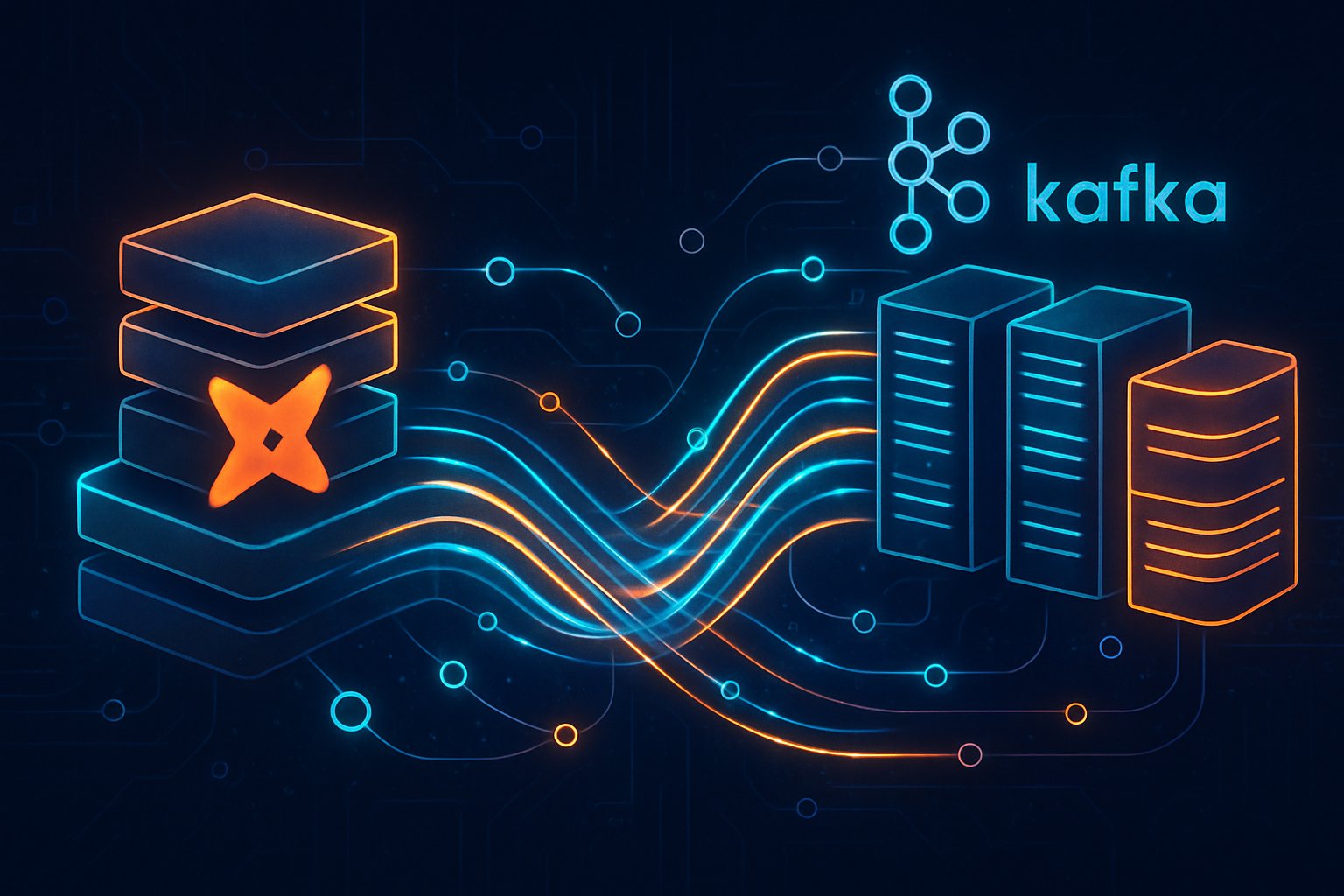
Streaming data pipelines process events in real-time using Apache Kafka for data transport and dbt for transformations. These systems handle continuous data flows differently than traditional batch processing methods.
Key Concepts in Streaming Data Modeling
Events form the basic unit of streaming data. Each event represents something that happened at a specific time. Examples include user clicks, sensor readings, or database changes.
Stream processing handles these events as they arrive. The system processes data continuously instead of waiting for large batches to accumulate.
Apache Kafka acts as the central nervous system. It receives events from different sources and sends them to various destinations. Kafka topics organize events by type or source.
Data pipeline architecture connects producers to consumers. Producers send events to Kafka topics. Consumers read from these topics and process the data.
The data build tool (dbt) transforms streaming data after it lands in a data warehouse. It applies business logic and creates clean, usable datasets from raw event streams.
Differences Between Batch and Streaming Data
Batch processing collects data over time periods like hours or days. It processes large chunks of data all at once. This approach works well for historical analysis and reporting.
Streaming data flows continuously. The system processes each event within seconds or milliseconds of arrival. This enables real-time alerts and immediate responses.
Latency differs greatly between approaches:
- Batch: Minutes to hours
- Streaming: Milliseconds to seconds
Data freshness varies by method:
- Batch: Updated on schedule
- Streaming: Always current
Processing complexity changes too. Batch jobs handle complete datasets with clear start and end points. Streaming requires handling incomplete information and out-of-order events.
Role of dbt and Kafka in Modern Data Architectures
Apache Kafka handles the transport layer in streaming architectures. It receives events from applications, databases, and external systems. Kafka ensures reliable delivery and can replay events if needed.
Kafka connects to data warehouses like Snowflake or BigQuery. Connectors stream events directly into warehouse tables. This creates a bridge between real-time systems and analytical databases.
dbt transforms the raw streaming data once it reaches the warehouse. It applies the same modeling techniques used for batch data. dbt creates staging tables, applies business rules, and builds final data models.
The combination enables both real-time and analytical use cases. Applications can respond to events immediately through Kafka. Analysts can query clean, transformed data through dbt models.
Modern data teams use this pattern to support:
- Real-time dashboards
- Immediate alerting systems
- Historical trend analysis
- Machine learning features
Setting Up the Streaming Architecture
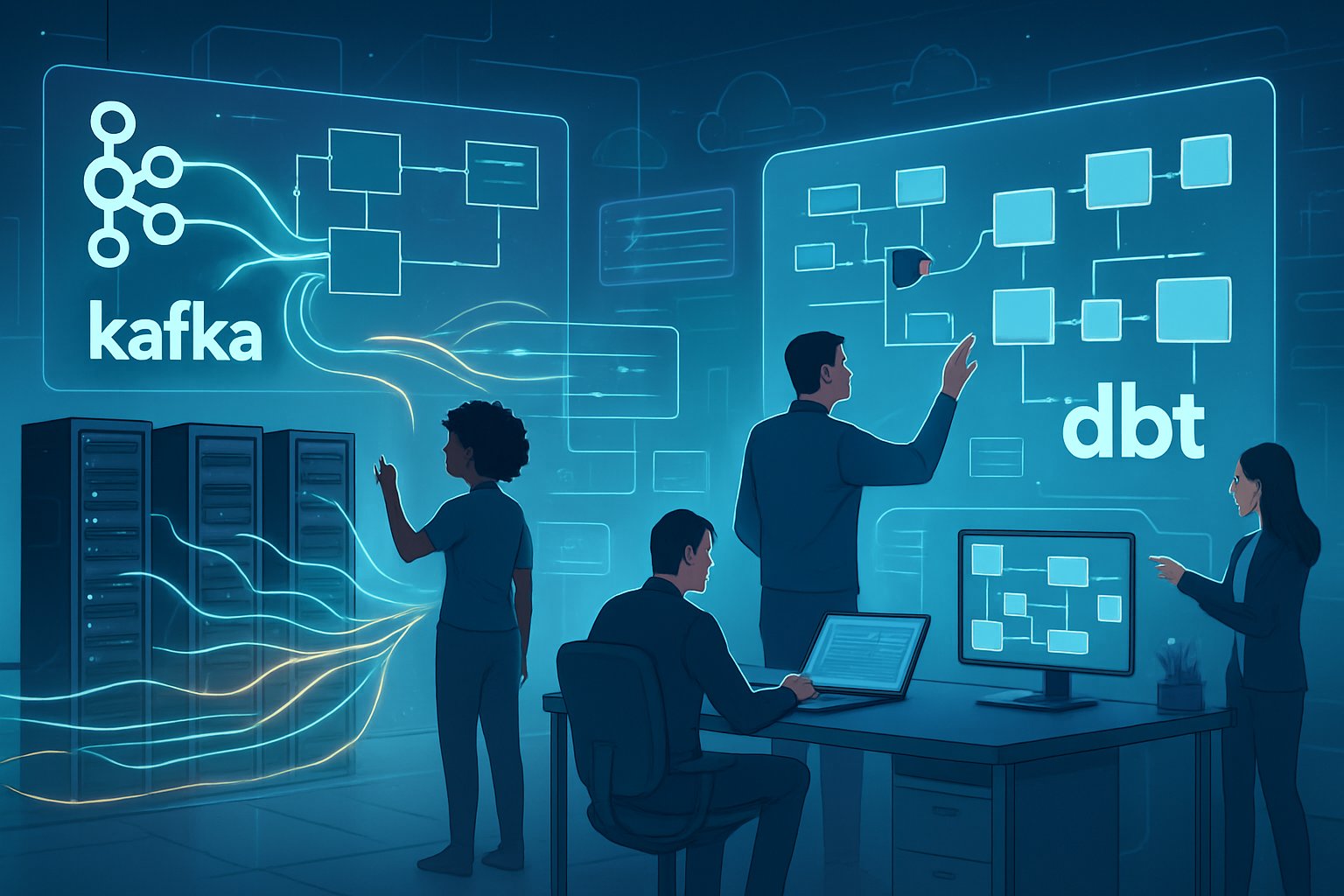
Building a streaming data pipeline requires three main components: a properly configured Kafka cluster for message handling, producer and consumer applications for data flow, and containerized deployment for easy management and scaling.
Kafka Cluster Deployment and Configuration
A Kafka cluster forms the backbone of any streaming data architecture. The cluster needs at least three broker nodes to ensure high availability and fault tolerance.
Broker Configuration
Each Kafka broker requires specific settings for optimal performance. Set the num.partitions to 3 or more for parallel processing. Configure replication.factor to 3 for data safety.
The log.retention.hours setting controls how long messages stay in topics. Set this to 168 hours (7 days) for most use cases. Adjust log.segment.bytes to 1GB for better disk management.
Network and Storage Setup
Configure listeners and advertised.listeners correctly for client connections. Use separate disks for Kafka logs and system files when possible.
Set min.insync.replicas to 2 to ensure data durability. This prevents data loss during broker failures.
Data Ingestion Using Kafka Producers and Consumers
Kafka producers send data to topics while consumers read and process messages. Both components need proper configuration for reliable data streaming.
Producer Configuration
Configure producers with acks=all to ensure message delivery. Set retries to 3 for automatic retry on failures. Use batch.size=16384 and linger.ms=5 for better throughput.
Enable compression with compression.type=snappy to reduce network usage. Set appropriate buffer.memory based on expected data volume.
Consumer Configuration
Consumer groups allow multiple consumers to process data in parallel. Set enable.auto.commit=false for manual offset management. Configure max.poll.records based on processing capacity.
Use auto.offset.reset=earliest to process all available data from topic start. Set session.timeout.ms appropriately for your processing time needs.
Containerization with Docker and Docker Compose
Docker containers make Kafka deployment simple and portable. Docker Compose orchestrates multiple containers including Kafka brokers, Zookeeper, and monitoring tools.
Docker Compose Setup
Create a docker-compose.yml file with Kafka and Zookeeper services. Map ports 9092 for Kafka and 2181 for Zookeeper. Set appropriate memory limits for each container.
Use environment variables for configuration flexibility. Mount volumes for persistent data storage across container restarts.
Container Networking
Configure container networks to allow communication between Kafka brokers. Set KAFKA_ADVERTISED_LISTENERS to include both internal and external addresses.
Use health checks to ensure containers start in the correct order. Zookeeper must be ready before Kafka brokers start.
Integrating dbt with Streaming Data Sources

Connecting dbt to streaming data requires moving event data from Apache Kafka into a data warehouse where dbt can transform it. Teams must handle schema changes carefully and choose the right tools to ensure data flows smoothly from streams to tables.
Loading Kafka Data into the Data Warehouse
dbt cannot directly connect to Kafka streams. Instead, teams must first load the streaming data into a warehouse like Snowflake, BigQuery, or Databricks.
Batch Loading Approach
Many teams use scheduled batch jobs to pull data from Kafka topics. These jobs run every few minutes to load new events into staging tables. This method works well for most use cases that don’t need real-time updates.
Streaming Database Options
Some platforms like Materialize and Databricks offer streaming tables that can connect directly to Kafka. These systems update results as new events arrive. dbt can then transform this streaming data using regular SQL models.
CDC and Event Sourcing
Change data capture (CDC) tools can stream database changes to Kafka. Teams often use this pattern to rebuild tables from event streams. Each event represents a change that dbt models can process to create the final table state.
Using Kafka Connectors and ETL Tools
Kafka Connect provides pre-built connectors that move data between Kafka and data warehouses. These connectors handle the heavy work of data movement without custom code.
Popular Connector Options
- Confluent Cloud connectors for Snowflake, BigQuery, and S3
- Debezium connectors for database CDC
- Custom JDBC connectors for specific databases
ETL Pipeline Integration
Tools like Airbyte, Fivetran, and Stitch can pull data from Kafka topics. These platforms handle schema mapping and load data into warehouse tables. dbt then transforms the loaded data using its standard workflow.
Real-time Processing
Some teams use Apache Flink or Kafka Streams for complex event processing. These tools can pre-process events before loading them into the warehouse. This approach reduces the transformation work that dbt needs to do later.
Managing Schema Changes and Event Formats
Event data schemas change over time as applications evolve. Teams need strategies to handle these changes without breaking dbt models or losing data.
Schema Registry Benefits
Confluent Schema Registry stores Avro schemas for Kafka topics. This registry enforces schema rules and tracks changes over time. ETL tools can use the registry to handle schema evolution automatically.
Avro Schema Evolution
Avro supports backward and forward compatibility rules. Teams can add new fields or change field types while keeping old data readable. This flexibility helps prevent pipeline failures when applications update their event formats.
dbt Model Strategies
Teams should build dbt models that expect schema changes. Using select * can break when new fields appear. Instead, models should explicitly list expected columns and use try_cast() functions for type conversions.
Testing and Monitoring
dbt tests can catch schema problems early. Teams should add tests that check for expected columns and data types. Monitoring tools can alert when event formats change unexpectedly.
Designing Robust dbt Models for Streaming Data

Streaming data requires specific model design patterns that handle continuous data flow and frequent updates. dbt models must use incremental materializations and specialized SQL logic to process insert, update, and delete operations efficiently.
Incremental Models and Materializations
Incremental models form the backbone of streaming data transformations in dbt. These models only process new or changed records instead of rebuilding entire datasets.
The incremental materialization strategy processes data in small batches. This approach reduces compute costs and improves performance for large datasets. Models use the is_incremental() macro to determine whether to run in full refresh or incremental mode.
Key configuration options:
unique_key: Identifies records for updateson_schema_change: Handles column changesincremental_strategy: Defines merge behavior
SQL transforms in incremental models filter data using watermark columns. Common filters include timestamp fields or sequence numbers that identify new records.
{{ config(materialized='incremental', unique_key='id') }}
select * from {{ source('kafka', 'events') }}
{% if is_incremental() %}
where updated_at > (select max(updated_at) from {{ this }})
{% endif %}Materialized views offer another option for streaming contexts. They automatically update when source data changes, eliminating the need for scheduled runs.
Handling Inserts, Updates, and Deletes in Streaming Contexts
Streaming systems produce three types of operations that require different handling strategies. Each operation type needs specific SQL logic to maintain data accuracy.
Insert operations add new records to target tables. These are straightforward to handle in incremental models using basic append logic.
Update operations modify existing records. The merge incremental strategy handles updates by matching on the unique key. When matches occur, dbt updates the existing record with new values.
Delete operations remove records from the target dataset. Kafka streams often include tombstone records or delete markers. Models use conditional logic to identify and remove deleted records.
Post-hooks handle delete operations effectively:
{{ config(
post_hook="delete from {{ this }} where op = 'd'"
) }}Row numbering helps identify the latest version of each record. Window functions with ROW_NUMBER() over partition keys ensure only the most recent version remains active.
Data transformations must account for out-of-order messages common in distributed streaming systems. Proper ordering logic prevents stale data from overwriting newer records.
Orchestration and Automation of Streaming Pipelines
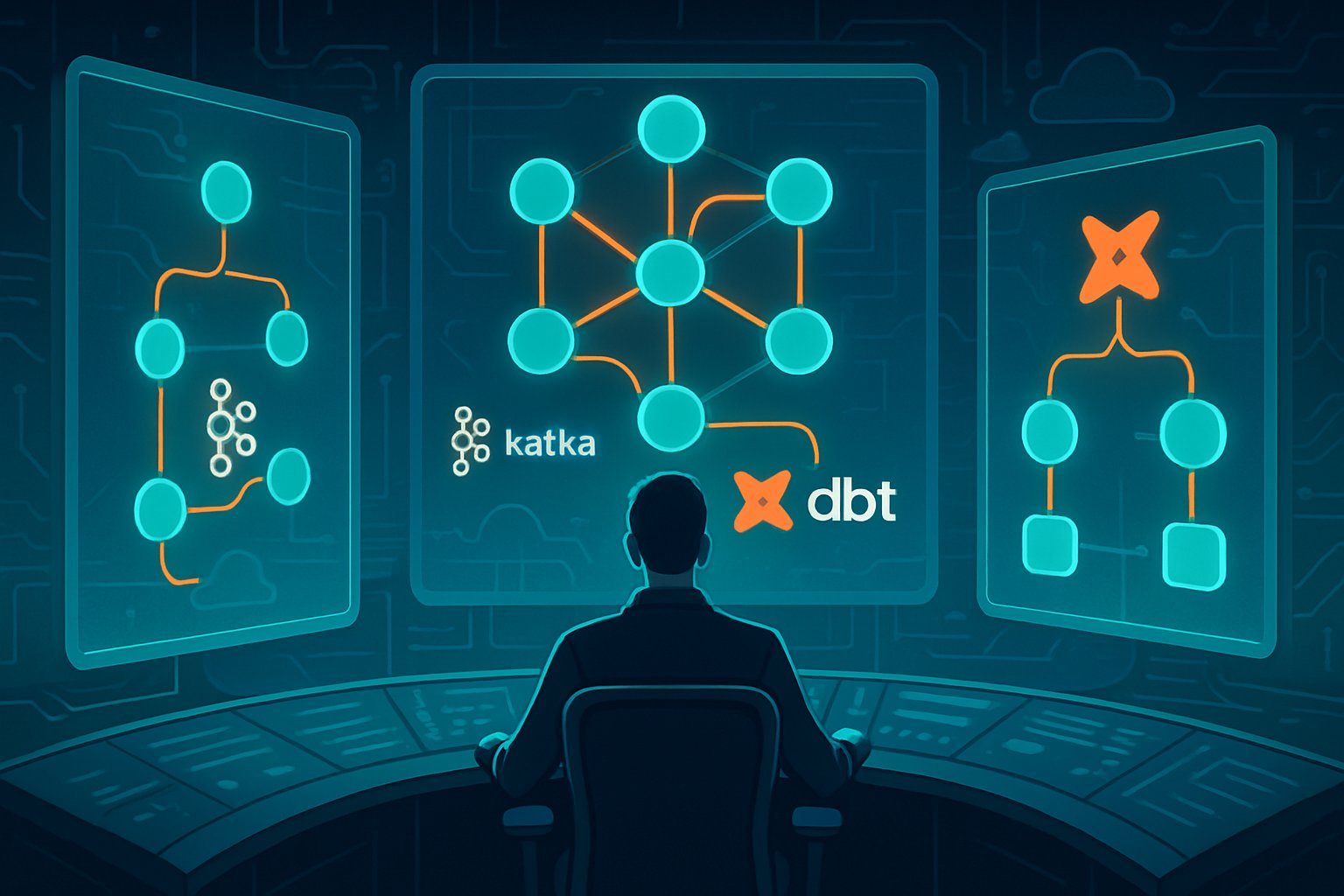
Managing streaming data pipelines requires robust orchestration tools to handle complex workflows and automated scheduling. Version control systems ensure teams can collaborate effectively while maintaining code quality and deployment consistency.
Workflow Management with Apache Airflow and dbt Cloud
Apache Airflow serves as the primary orchestration engine for streaming data pipelines. It manages dependencies between Kafka consumers, dbt model runs, and downstream processes.
Airflow DAGs define the execution order of tasks. Data engineers create sensors that monitor Kafka topics for new messages. These sensors trigger dbt Cloud jobs when fresh data arrives.
Key Airflow operators for streaming pipelines:
KafkaSensor– Monitors topic partitionsdbtCloudRunJobOperator– Executes dbt modelsDockerOperator– Runs containerized transformations
dbt Cloud provides REST APIs for job scheduling. Airflow calls these APIs to trigger specific model runs. This approach separates orchestration logic from transformation code.
Scheduling strategies include:
- Micro-batching – Process data every few minutes
- Event-driven – Trigger on message arrival
- Hybrid – Combine time and event triggers
Teams configure retry policies and failure notifications. Airflow handles task failures gracefully by retrying failed jobs and sending alerts.
Version Control and Collaboration Best Practices
Git repositories store all pipeline code including Airflow DAGs and dbt models. Teams use branching strategies to manage development workflows safely.
Essential Git practices:
- Feature branches for new models
- Pull requests for code review
- Protected main branches
- Automated testing on commits
dbt Cloud integrates directly with Git providers. Developers commit model changes to feature branches. The platform automatically runs tests before merging code.
CI/CD pipeline steps:
- Developer pushes code changes
- Automated tests run on dbt models
- Code review and approval process
- Merge to main branch triggers deployment
Environment separation prevents production issues. Teams maintain separate Git branches for development, staging, and production environments.
Code reviews focus on SQL quality and model logic. Teams establish naming conventions and documentation standards. This ensures consistent code quality across all streaming models.
Ensuring Data Quality and Consistency
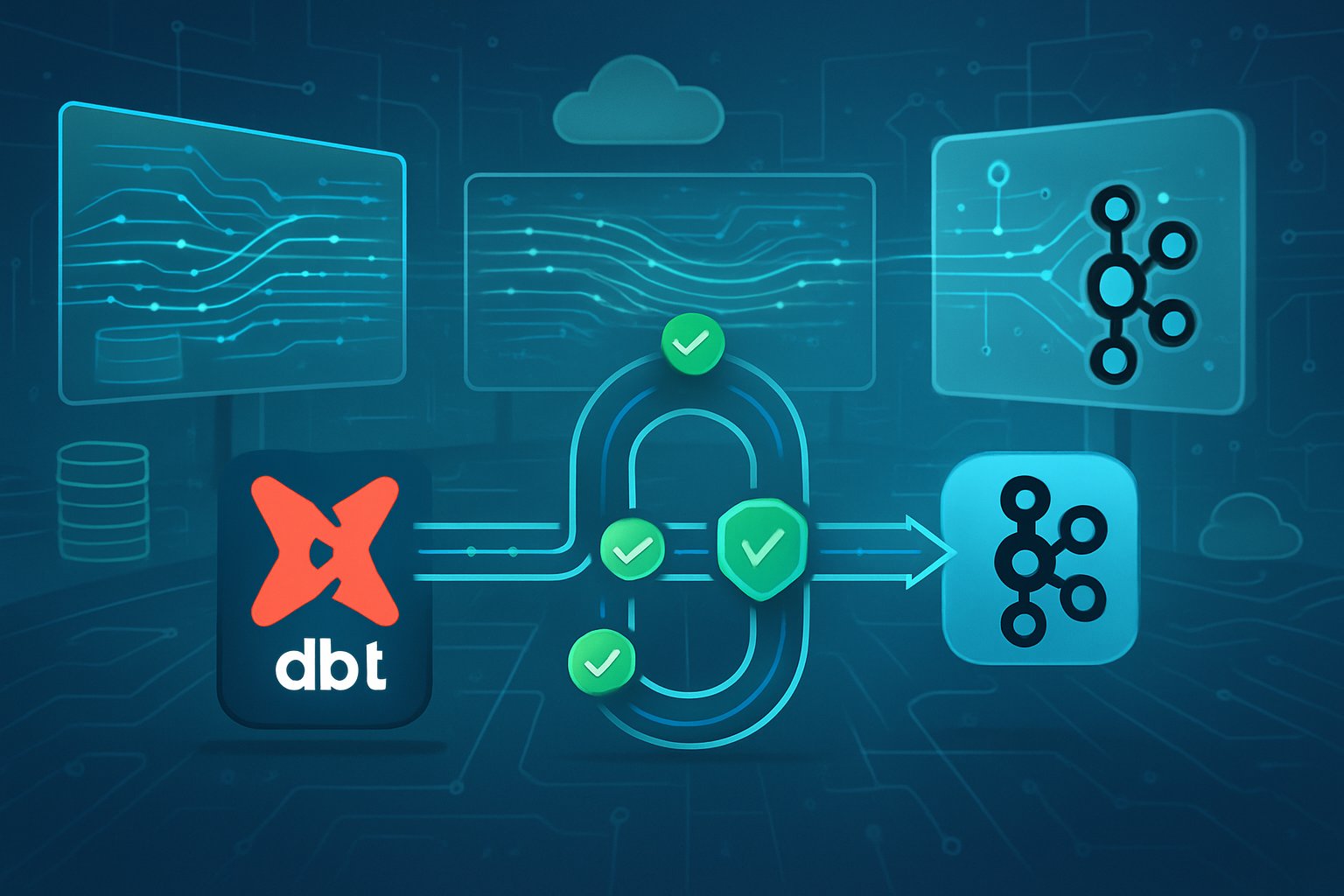
Data quality issues multiply when streaming data flows through Kafka to dbt transformations. Teams need robust testing frameworks and error handling strategies to catch problems before they affect downstream analytics.
Testing and Validating Streaming Data Transformations
dbt provides built-in testing capabilities that work well with streaming data models. Teams can define tests directly in their dbt_project.yml file or create separate test files.
Schema tests validate basic data structure rules. These include:
not_nulltests for required fieldsuniquetests for primary keysaccepted_valuestests for categorical datarelationshipstests for foreign keys
Data freshness tests become critical with streaming data. Teams configure these tests to alert when data stops flowing from Kafka topics.
Custom tests handle complex business logic validation. Data engineers write SQL-based tests as macros in their dbt projects.
-- Example freshness test in schema.yml
freshness:
warn_after: {count: 1, period: hour}
error_after: {count: 6, period: hour}Teams should run tests after each micro-batch transformation. This catches data quality issues quickly before they propagate downstream.
Managing Error Handling and Recovery
Error handling in streaming dbt workflows requires careful planning. Teams must decide how to handle bad records without stopping the entire pipeline.
Dead letter queues in Kafka capture records that fail transformation. Teams configure these queues to store problematic messages for later review.
Incremental model strategies help with recovery. When errors occur, teams can reprocess specific time windows without affecting the entire dataset.
Configuration management through profiles.yml enables different error handling for development and production environments. Teams set stricter validation rules in production.
Monitoring and alerting catch issues early. Teams integrate dbt test results with monitoring tools to get notifications when data quality drops.
Retry mechanisms handle temporary failures. Teams configure automatic retries for network issues or temporary database unavailability while logging persistent errors for manual review.
Monitoring, Visualization, and Real-Time Analytics

Effective monitoring and visualization are critical for maintaining healthy streaming data pipelines and extracting actionable insights from real-time data flows. Modern streaming analytics platforms require comprehensive observability tools and dashboarding solutions to ensure optimal performance and business value.
Streaming Analytics and Dashboarding Tools
Real-time dashboards transform streaming data into visual insights that teams can act upon immediately. Tools like Kibana, Power BI, and Grafana connect directly to streaming data sources to display live metrics and trends.
Popular Streaming Visualization Tools:
- Kibana: Works with Elasticsearch to visualize log data and streaming events
- Power BI: Integrates with Azure Stream Analytics for real-time business dashboards
- Grafana: Displays time-series data from multiple streaming sources
- Tableau: Offers real-time data connections for streaming analytics
These tools process data streams with low latency. They update visualizations as new data arrives from Kafka topics or other streaming sources.
Teams can build custom dashboards that show key performance indicators. Charts update every few seconds to reflect current system status and business metrics.
Performance Monitoring with Grafana and Prometheus
Grafana and Prometheus form a powerful monitoring stack for streaming data pipelines. Prometheus collects metrics from Kafka brokers, dbt models, and processing engines. Grafana displays these metrics in customizable dashboards.
Key Metrics to Monitor:
- Kafka consumer lag and throughput rates
- dbt model execution times and success rates
- Data pipeline error rates and latency
- Resource usage across streaming infrastructure
Prometheus scrapes metrics from application endpoints every few seconds. It stores time-series data that Grafana queries to create real-time charts and alerts.
Teams set up alerts for critical thresholds. When consumer lag exceeds limits or error rates spike, the system sends notifications to operations teams.
Real-Time Analytics Use Cases
Streaming analytics enables businesses to respond quickly to changing conditions. Financial companies use real-time data to detect fraud within seconds of transactions occurring.
E-commerce platforms track user behavior streams to personalize recommendations instantly. They analyze click patterns and purchase data as events happen.
Manufacturing systems monitor sensor data to predict equipment failures. Machine learning models process streaming telemetry to identify anomalies before breakdowns occur.
Common Analytics Patterns:
- Fraud detection on payment streams
- Real-time recommendation engines
- IoT sensor monitoring and alerting
- Social media sentiment tracking
These use cases require streaming pipelines that process high-volume data with minimal delay. Organizations combine Kafka for data ingestion with analytics engines for real-time processing.
Advanced Topics and Future Directions
Modern streaming data architectures enable machine learning workflows on real-time data, seamless integration with cloud warehouses like Snowflake and BigQuery, and horizontal scaling patterns that handle massive data volumes.
Machine Learning on Streaming Data
Machine learning models require continuous data feeds to maintain accuracy and relevance. Streaming pipelines built with Kafka and dbt provide the foundation for real-time ML workflows.
Feature engineering becomes critical in streaming environments. dbt models can transform raw event data into features that ML algorithms need. These transformations happen in real-time as data flows through the pipeline.
Python-based ML frameworks integrate well with streaming architectures. Tools like Apache Spark can consume processed data from dbt models and apply machine learning algorithms immediately.
Model serving requires special consideration in streaming contexts. Models must process individual events or small batches quickly. The latency between data ingestion and prediction directly impacts business value.
Real-time anomaly detection represents a common use case. Financial institutions use streaming ML to detect fraudulent transactions within milliseconds of occurrence.
Cloud Data Warehouses and Data Lakes Integration
Cloud platforms offer managed services that simplify streaming data integration. Snowflake provides native Kafka connectors that stream data directly into warehouse tables.
BigQuery supports streaming inserts through its API and Dataflow integration. This allows dbt models to process data as soon as it arrives in the warehouse.
Data lakes complement warehouses in streaming architectures. Raw event data flows into lakes like Amazon S3 for long-term storage. Processed data moves to warehouses for analytics.
Delta Lake and Apache Iceberg provide ACID transactions for streaming data. These technologies ensure data consistency when multiple processes write to the same tables simultaneously.
The medallion architecture works well with streaming data. Bronze tables store raw events, silver tables apply business rules, and gold tables serve analytics workloads.
Scaling Streaming Pipelines
Kafka partitioning enables horizontal scaling across multiple nodes. Each partition processes independently, allowing throughput to increase with additional hardware.
Consumer groups distribute processing load across multiple dbt instances. This approach prevents bottlenecks when data volume exceeds single-node capacity.
Resource management becomes crucial at scale. Memory and CPU requirements grow with data velocity and transformation complexity. Container orchestration platforms like Kubernetes help manage these resources.
Back-pressure handling prevents system overload during traffic spikes. Proper configuration ensures data quality remains consistent even when processing falls behind ingestion rates.
Monitoring and alerting systems track pipeline health. Key metrics include processing latency, error rates, and resource utilization across all pipeline components.
Frequently Asked Questions
Managing streaming data with dbt and Kafka involves specific technical considerations around integration patterns, data quality controls, and scaling strategies. These questions address the practical challenges developers face when building real-time data models.
What are the best practices for integrating dbt with Kafka to manage streaming data?
The most effective approach uses Kafka as the streaming foundation with dbt handling downstream transformations. Organizations should set up Kafka to stream events from various sources to data warehouses like Snowflake or Databricks.
A near real-time pipeline works well for most use cases. This involves streaming data from source systems through Kafka connectors into a data warehouse where dbt models can process it.
Developers should separate streaming ingestion from transformation logic. Kafka handles the event streaming while dbt focuses on modeling the landed data into analytics-ready tables.
Using tools like Debezium connectors helps capture change data from databases. These connectors send records as JSON to Kafka topics, which then flow into warehouse tables for dbt processing.
How can you ensure data quality when using dbt with Kafka streams?
Data quality requires validation at multiple stages of the streaming pipeline. dbt tests should run on all models that process streaming data to catch issues early.
Implementing schema validation in Kafka producers prevents malformed messages from entering the stream. This reduces downstream data quality problems in dbt models.
Setting up monitoring for both Kafka lag and dbt model freshness helps identify data flow issues. Teams should track metrics like message processing times and transformation success rates.
Using dbt’s incremental models with proper merge strategies ensures data consistency. These models can handle late-arriving data and duplicate records common in streaming scenarios.
What are the strategies for handling schema evolution in Kafka when using dbt?
Schema evolution requires coordination between Kafka producers and dbt models. Using a schema registry helps manage changes to message formats over time.
Forward-compatible schemas work best for streaming scenarios. Adding new optional fields allows producers to evolve without breaking existing dbt models.
dbt models should use flexible column extraction patterns when working with JSON payloads from Kafka. This allows models to handle new fields without immediate code changes.
Implementing versioned data models helps manage breaking schema changes. Teams can run multiple model versions during transition periods to ensure continuity.
How does dbt fit into a real-time data infrastructure with Kafka?
dbt typically operates on the analytical side of streaming architectures. Kafka handles real-time event collection while dbt transforms the landed data for analytics use cases.
The integration works through a two-stage process. Kafka streams data into storage systems, then dbt models transform this data into dimensional models and metrics.
Modern platforms like Materialize enable dbt models to work directly with streaming data. This allows the same SQL transformations used in batch processing to work on real-time streams.
Databricks supports streaming tables that work with dbt models. These create Delta Live Tables internally, enabling streaming transformations within familiar dbt workflows.
What are the common challenges when modeling streaming data with dbt and how can they be addressed?
The main challenge stems from dbt’s batch processing nature versus stream processing requirements. Traditional dbt operates on static datasets, while streams continuously change.
Late-arriving data creates modeling complexity. Using dbt’s incremental models with lookback windows helps capture delayed records without full table rebuilds.
Handling out-of-order events requires careful timestamp-based logic in dbt models. Developers should implement proper windowing and deduplication strategies.
State management becomes critical with streaming data. dbt models need to track processed records and handle restarts without data loss or duplication.
How can you scale dbt models and Kafka streams to handle high volumes of data efficiently?
Kafka scaling involves partitioning topics appropriately and distributing load across multiple consumer groups. This enables parallel processing of high-volume streams.
dbt models should use incremental processing strategies to handle large data volumes. Processing only new or changed records reduces compute costs and improves performance.
Implementing proper data partitioning in the target warehouse helps dbt models process streaming data efficiently. Time-based partitions work well for most streaming scenarios.
Using microbatch processing patterns helps balance latency and throughput. This involves processing small batches of streaming data at regular intervals rather than record-by-record processing.
Resource optimization requires tuning both Kafka consumer settings and dbt model configurations. Teams should monitor CPU, memory, and network usage to identify bottlenecks.




